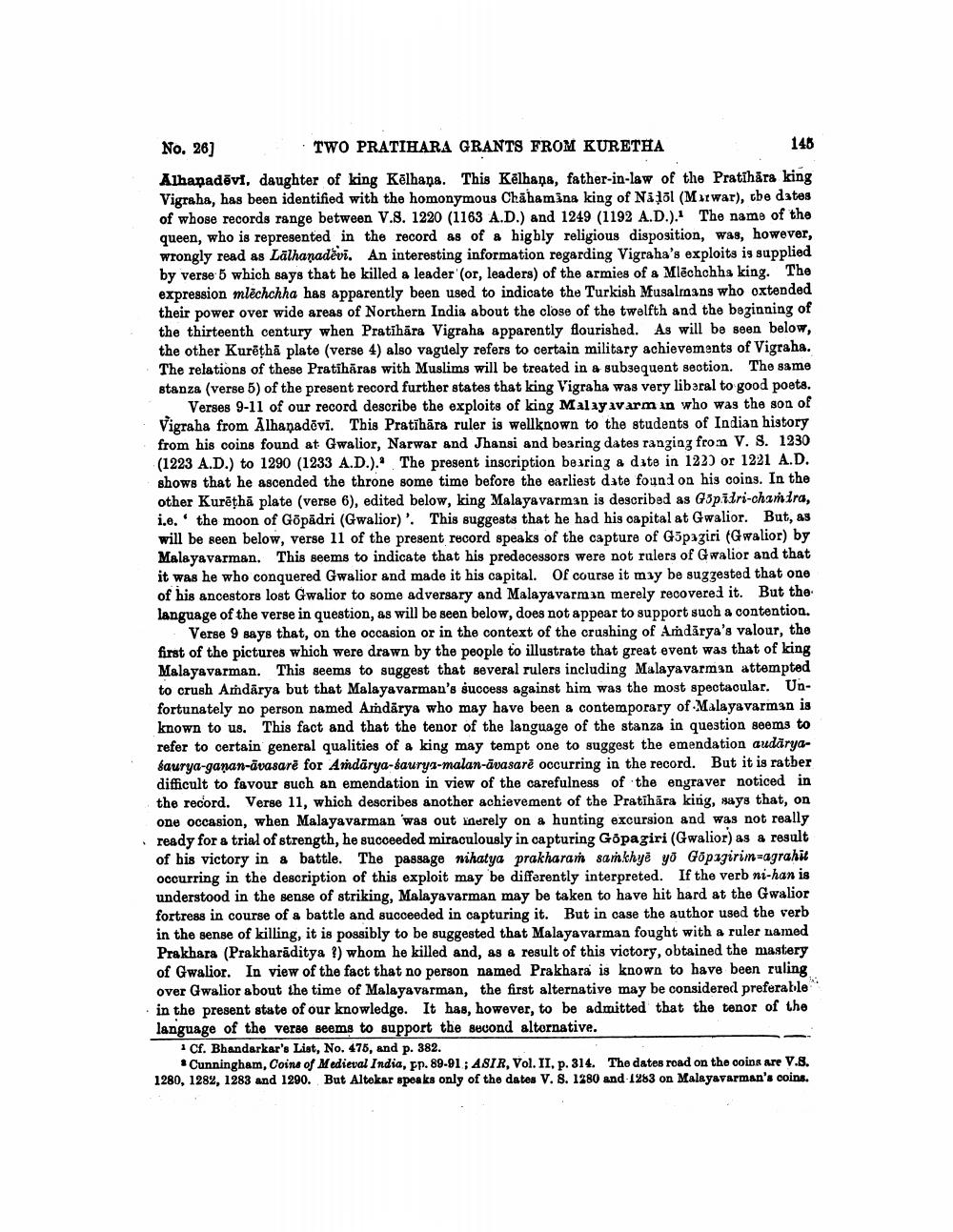________________
No. 26] TWO PRATIHARA GRANTS FROM KURETHA
148 Alhanadēvi, daughter of king Kēlhana. This Kēlhana, father-in-law of the Pratīhāra king Vigraha, has been identified with the homonymous Chāhamina king of Nalol (Marwar), the dates of whose records range between V.8. 1220 (1163 A.D.) and 1249 (1192 A.D.). The name of the queen, who is represented in the record as of a highly religious disposition, was, however, wrongly read as Lālhanadèvi. An interesting information regarding Vigraha's exploits is supplied by verse 5 which says that he killed a leader (or, leaders) of the armies of a Mlēchchha king. The expression mléchchha has apparently been used to indicate the Turkish Musalmans who oxtended their power over wide areas of Northern India about the close of the twelfth and the beginning of the thirteenth century when Pratīhāra Vigraha apparently flourished. As will be seen below, the other Kurēthā plate (verse 4) also vaguely refers to certain military achievements of Vigraha. The relations of these Pratihāras with Muslims will be treated in a subsequent section. The same stanza (verse 5) of the present record further states that king Vigraha was very liberal to good poets.
Verses 9-11 of our record describe the exploits of king Malayavarm in who was the son of Vigraha from Alhanadovi. This Pratihāra ruler is wellknown to the students of Indian history from his coins found at Gwalior, Narwar and Jhansi and bearing dates ranging from V. S. 1230 (1223 A.D.) to 1290 (1233 A.D.). The present inscription bearing a date in 122) or 1221 A.D. shows that he ascended the throne some time before the earliest date found on his coins. In the other Kurēthā plate (verse 6), edited below, king Malayavarman is described as G3piri-chandra, i.e. the moon of Göpādri (Gwalior)'. This suggests that he had his capital at Gwalior. But, as will be seen below, verse 11 of the present record speaks of the capture of G5pagiri (Gwalior) by Malayavarman. This seems to indicate that his predecessors were not rulers of Gwalior and that it was he who conquered Gwalior and made it his capital. Of course it may be suggested that one of his ancestors lost Gwalior to some adversary and Malayavarman merely recovered it. But the language of the verse in question, as will be seen below, does not appear to support such a contention.
Verse 9 says that, on the occasion or in the context of the crushing of Amdărya's valour, the first of the pictures which were drawn by the people to illustrate that great event was that of king Malayavarman. This seems to suggest that several rulers including Malayavarman attempted to crush Amdārya but that Malayavarman's success against him was the most spectacular. Unfortunately no person named Amdärya who may have been a contemporary of Malayavarman is known to us. This fact and that the tenor of the language of the stanza in question seems to refer to certain general qualities of a king may tempt one to suggest the emendation audāryasaurya-ganan-āvasarë for Andārya-saurya-malan-āvasare occurring in the record. But it is ratber difficult to favour such an emendation in view of the carefulness of the engraver noticed in the record. Verse 11, which describes another achievement of the Pratihāra king, says that, on one occasion, when Malayavarman was out increly on a hunting excursion and was not really ready for a trial of strength, he succeeded miraculously in capturing Gopagiri (Gwalior) as a result of his victory in a battle. The passage nihatya prakharan samkhye yo Gopagirim-agrahit occurring in the description of this exploit may be differently interpreted. If the verb ni-han is understood in the sense of striking, Malayavarman may be taken to have hit hard at the Gwalior fortress in course of a battle and succeeded in capturing it. But in case the author used the verb in the sense of killing, it is possibly to be suggested that Malayavarman fought with a ruler named Prakhara (Prakharāditya ?) whom he killed and, as & result of this victory, obtained the mastery of Gwalior. In view of the fact that no person named Prakhara is known to have been ruling over Gwalior about the time of Malayavarman, the first alternative may be considered preferable in the present state of our knowledge. It has, however, to be admitted that the tenor of the language of the verso seems to support the second alternative.
* Cf. Bhandarkar's List, No. 476, and p. 382.
* Cunningham, Coins of Medieval India, Ep. 89-91; ASIR, Vol. II, p. 314. The dates road on the coins are V.8. 1280, 1282, 1283 and 1290. But Altokar speaks only of the dates V. 8. 1280 and 1283 on Malayavarman's coins.




